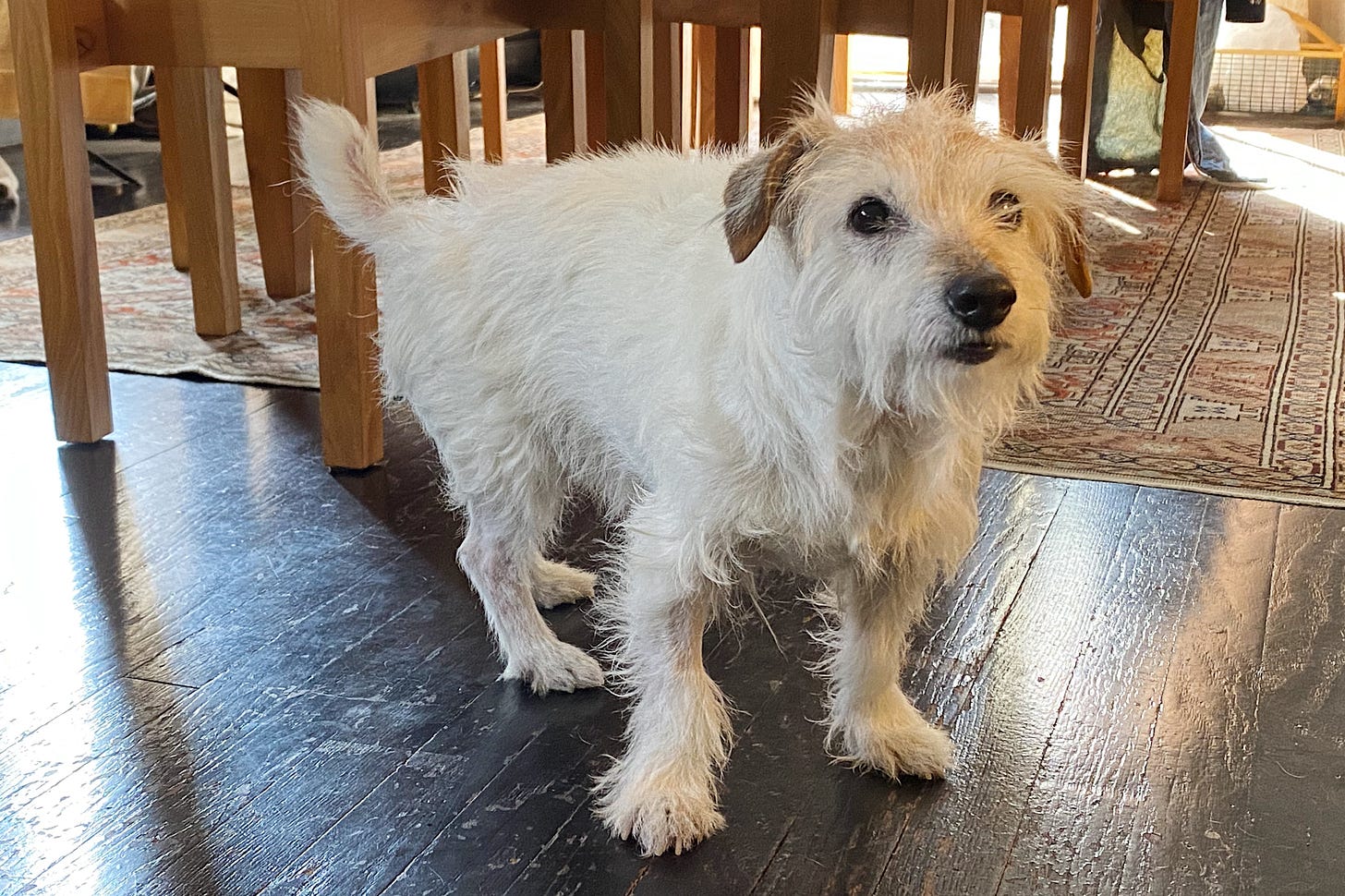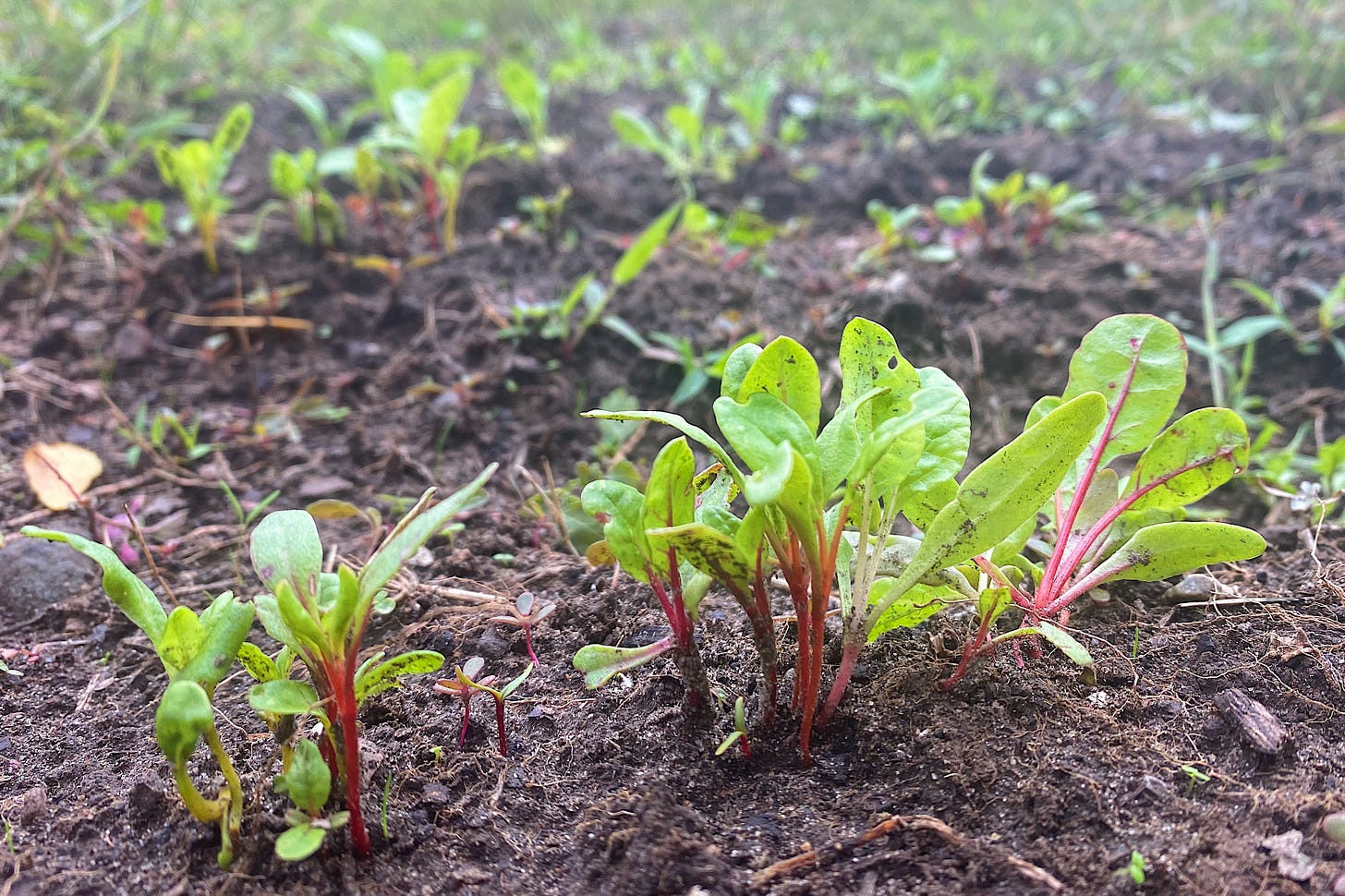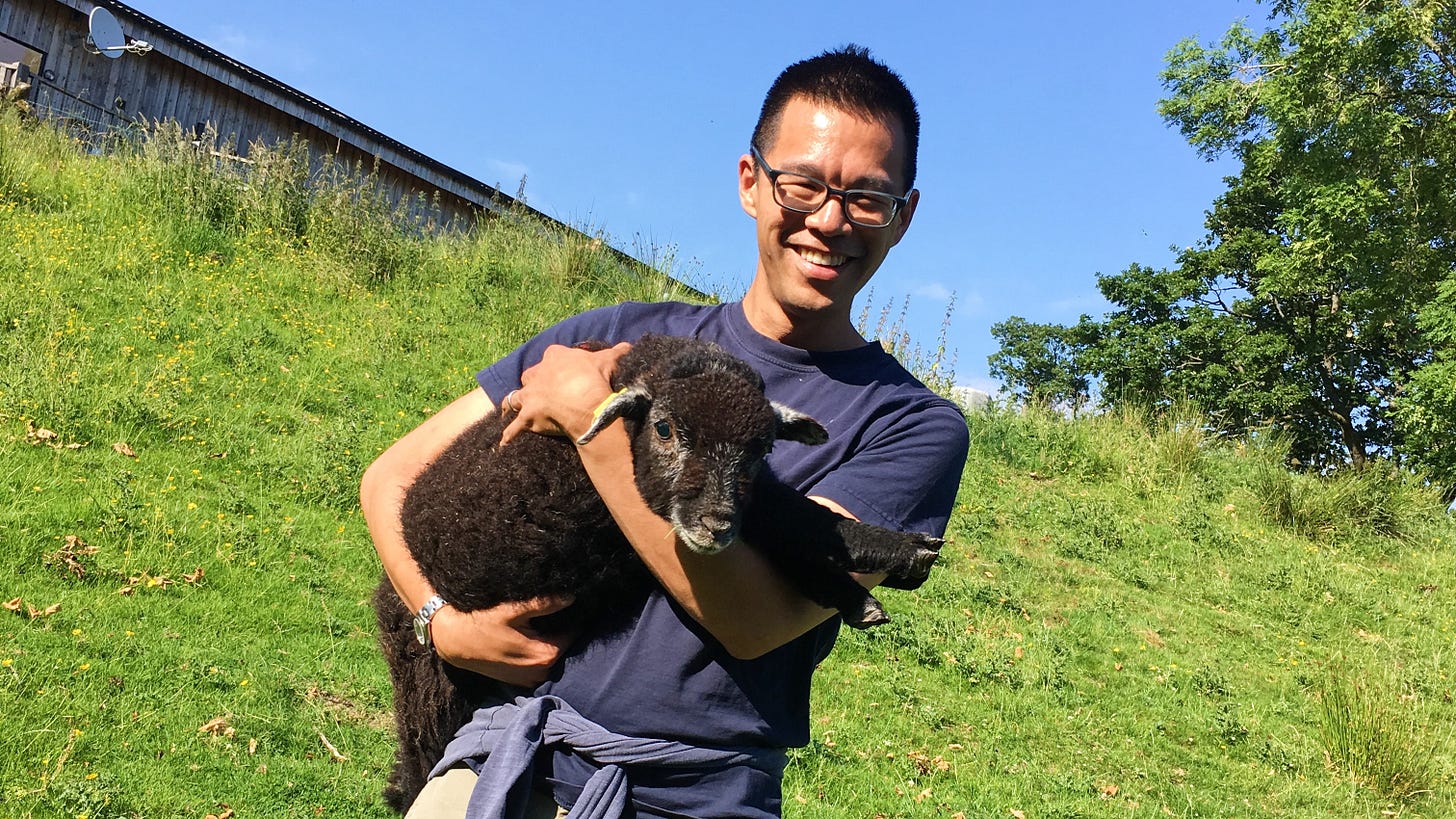Understanding the Fires
Some fragmented thoughts on the wildfires out West, the long-term consequences of cultural ignorance, attentiveness, questions, tomatoes, and lasagna
The 106th Day after Coronatide*
Grand Rapids, Michigan
Greetings, dear reader.
I got a note from one of you last week, saying that my headline, “We Love Most What Passes Away,” sparked panic: Did Fozzie die? No, Fozzie did not die. Here he is today, glowering at me for taking a picture of him rather than taking him outside.

He has had a rough stretch, first with dental surgery last month and then what we think was a badly infected bug bite. He was lethargic for a couple of days, but is clearly feeling better. He’s now back to his work Fozzifying our household, a holistic program that includes seven, maybe eight walks per day. At least we’re getting our steps.
On our walks over the past several days, we’ve seen the haze in the sky—evidence of the fires far to our west. I am proudly a child of California. My mom graduated from the University of Oregon. (Go Ducks!) And as a kid, I had formative experiences visiting my bonus “grandparents” in southwestern Washington; Uncle Jack, as we called him, was a logger, and one summer, my sister and I helped set chokers on fallen trees on their land—stories for another time. So this grieves me on a personal level.
It’s not just sadness over the loss of life or the extra layer of grief in a year already so replete with it. It’s disappointment at yet another instance of the failure to love God well, the failure to honor the creation around us, and the failure to love our neighbor. And it’s anger—anger because we continue not to recognize how interconnected we are, anger at the foolishness and lack of care the smoke represents, and anger because the wisdom was there to prevent these massive blazes.
When settlers came to this continent and commodified the land, connections were broken, often violently, between peoples and their soils. The colonizers suppressed and in some cases extinguished integral parts of the cultures of the original stewards—those who knew it, who understood it, who carried its stories and its wisdom in their bones. But what they didn’t realize was that they had diminished their connection to their land too. In gazing far and wide and perceiving everything as available for conquest or purchase (on their terms), they also uprooted themselves. They failed to understand what they didn’t understand. They didn’t know how much they didn’t know. Willie James Jennings, who writes about this extensively and compellingly in The Christian Imagination, dubs it “the new groundlessness... detached from the land.”
It’s no mistake, I think, that the word “humility” is rooted in a Latin word for “earth” or “ground.” This week, I read a conversation published on Crosscut with four people who are intimately familiar with Indigenous land-management practices in the Pacific Northwest. Humility is what radiated from the words of Steve Rigdon, a Yakama forester. “When you try to tame the wilderness, it’s a totally different beast. And nobody’s been able to tame it, not even Native Americans,” he said. “But what we’d been able to do is try to work with it, try to find opportunities where they may lie, be sensible about it and [create] a continuous relationship, a continuous interaction.”
When the European settlers arrived, they didn’t understand this relationship with the land nor did they try to comprehend the interaction. “To them,” said Emily Washines, another Yakama Tribe citizen, “we were just burning things up for no reason and it was very peculiar that they would be walking through areas that were charred. They didn’t understand why.”
A common impulse, when one encounters something foreign and seemingly dangerous, is to suppress and/or eliminate it. That is as true with people as it is with elements like fire. To many settlers, fire seemed like a threat. But like so much else, fire is not one-dimensional. In Scripture, for instance, we see that God can show up in fire. Sometimes fire does bring punishment and destruction. But more often, fire appears as a harbinger of transformation and a metaphor for movement.
This resonates with the traditional Chinese understanding of fire. Ancient Chinese philosophy held that fire must exist in harmony with water, wood, metal, and earth. These five fundamental elements are part of the endless cycle of change that marks life on this earth. Ideally, the five work in harmony with one another, sustaining and nourishing life. Out of balance, each has power to destroy. Of course it can be deadly and of course it can destroy. But fire can also offer cleansing and warmth, purification and sustenance, restoration and renewal.
Anyway, I digress: I was saying something about the land and honoring it and seeking to understand the lessons it offers and the cultures it has nourished. And some of you might be wondering, What do you expect us to do about any of this? My answer is, I don’t know. But my gut tells me that maybe it isn’t about implementing any particular set of actions—wouldn’t we be making the same mistake by assuming we have the knowledge we need to do what we need to do?
Maybe it’s more about cultivating a posture that then informs our decision-making.
Maybe it’s more about expanding our gaze from our own narrow story so that we can take in more of the stories with which mine, yours, ours connects.
Maybe it’s more about opening ourselves up to possibility.
Maybe it’s more about attentiveness.
Maybe in that posture of humility, of relationship, of openness, of attentiveness, we’ll find some of the answers we’re looking for.
At the Farminary, we would often ask a question of a newcomer: “What soils do you come from?” It was a way not only of asking them to dig toward their roots but also of beginning to forge relationship and connection. It’s a question that begets other questions. I think we need more of those.
I have only the briefest of histories with this land we now call West Michigan. These are not my soils. I’m still learning about them. As I’ve mentioned before, I planted Potawatomi pole beans in my community garden plot this summer. It’s the tiniest of nods to the people who came before, and the gesture—it’s only a gesture—is meant also to be a question: What else do I have to learn, beans? What stories haven’t I heard yet, soil? What else do you have to teach me, land?
Yes, sometimes when Tristan isn’t around, I do talk to the plants and the dirt and the things some deem inanimate. But others before me have done it too. I think of Hildegard of Bingen. It’s her feast day today in the Roman Catholic Church. She was a preacher and teacher, mystic and musician, playwright and linguist in 12th century Germany. If she were living and ministering today, she’d undoubtedly be branded a weirdo, given the odd beauty of her visions and writings. An editor might critique her overwrought and flowery prose, and all manner of Twitter theobrogians would question her exegesis—or even her right to exegete. (They’d find themselves in good company with some of Hildegard’s contemporaries, who thought her insubordinate and annoyingly opinionated.)
Yet Hildegard lived in the medieval era, and the passage of time offers wonderful opportunities for reputational enhancement. Hildegard is also eminently quotable, and here’s a relevant nugget for these days of fire and revealing: “The mysterious gifts of the Holy Spirit touch us human beings who have begun to become dull as a result of our boredom. As a result, we shall awaken from our dullness and arise vigorously toward justice. If we fall in love with creation deeper and deeper, we will respond to its endangerment with passion.”
I hope she’s right.
What I’m Growing: Before the rain came on Saturday, I went to the garden to harvest all the beans that I’ve been letting dry on the stalk. They’re so beautiful! Probably enough for one (small) pot of beans!

It also looks like we’ll get some chard and bok choy for the fall, and maybe even some spinach. That’s great, because my spring chard and spinach were a bust.

What I’m Cooking: If you want to know how we’re doing just over six months into relative lockdown, well, we just started a new-to-us season of Father Brown and we’re also watching Downton Abbey again from the very beginning. On Episode 1 of Downton, the cook Mrs. Patmore says, “Nothing makes you hungrier or more tired than grief.” Is that true? I’m not sure. I’ve had instances of grief that eviscerated my appetite. But maybe the extended grief of this time might explain why I’ve been cooking so much.
On Saturday morning, we headed to the farmers’ market early. Farmer Bob (whose name is not really Bob) has had excellent heirloom tomatoes all summer. I wanted to can some sauce, so I asked Bob if he had any tomatoes left. He said he had a few; I said I’d buy them all. It ended up being 21 pounds. He charged me $30. In New York, tomatoes at the farmers’ market cost $5 a pound. This is absurd—and we are grateful.
Looking ahead of winter, when we’ll crave the summer incarnate that the tomato represents, I made and canned 11 pints of arrabbiata sauce with that bounty. For Sunday dinner, we had a simple tomato salad—a couple of Bob’s tomatoes along with a few remnant Sungolds and basil from the garden, dressed in olive oil, a splash of balsamic, salt, and pepper. For dinner yesterday, I also cooked a big batch of the egg and tomato dish I wrote about some weeks ago. And since our mornings and evenings have begun to turn cool and the first signs of autumn are reddening the leaves, I made our first lasagna of the season.
Lasagna, unquestionably an Italian dish, tells a story of cultural intermingling. Yes, there’s that popular, probably untrue legend that Marco Polo introduced noodles to Italy from China. It’s more likely that Arabs spread their practice of making dried pasta to Sicily centuries earlier. Tomatoes belong neither to Italy nor to China; the Chinese characters for tomato, 番茄—pronounced faan keh in Cantonese and fānqié in Mandarin—translate literally as “barbarian eggplant,” so in our own clumsy way, we acknowledge it wasn’t ours. And basil likewise made its way westward along trade routes from its native India.
The lasagna I make is meatless. It has never turned out soggy or soupy for me—we love those crusty bits in the corners—and like all good lasagna, it’s even better as leftovers. The recipe is at the bottom of the email.
What I’m Reading: Since we’re on the theme of land and destruction this week, I guess it’s right that my copy of James Rebanks’s English Pastoral just arrived. James is an English shepherd. His previous book, The Shepherd’s Life, tells the truth about what being a shepherd means, and—spoiler alert—it is no gauzy flannel-graph Sunday-school story. A couple of summers ago, I was a student in a writing workshop James hosted on his farm in Cumbria. I got to hug a lamb. We also ate some lamb.

James is a brilliant writer, a beautiful thinker, and an all-around decent human. And English Pastoral asks some hard questions about how we treat the land that we allegedly love. It doesn’t come out until next spring here in the U.S., but Sam Read Bookseller, a terrific Lake District bookshop that has a particular interest in nature writing, will send you a copy.
What I’m Listening to: My friend Wes always has the most interesting song recommendations. This week, he sent me “Green Garden,” by the British songwriter Laura Mvula. Full of wonder and adoration, it’s a paean to a backyard from her childhood.
Whew, that was a lot of words. Sorry for being so long-winded. As always, I’m so glad we can stumble through all this together, and I’ll try to write again soon.
Yours,
Jeff
*I’m still counting the days from June 1, when my governor, Gretchen Whitmer, lifted Michigan’s stay-at-home order. This Sunday, my congregation will hold indoor, in-person worship for the first time. Yeah, I’m nervous. COVID-19 hasn’t disappeared. But I hope we’ll continue to wear our masks, love our neighbors, and stay safe.
Lasagna
Homemade tomato sauce
[Saute 1 chopped medium onion, 8 minced garlic cloves, 1 t dried oregano, 1 t dried basil, and 1 t crushed red pepper (or none if you don’t like spicy) in 4 T olive oil for about 5 minutes on medium-low heat. Then add 2 28-oz. cans of whole peeled tomatoes, 1 c crushed tomatoes, and 1/2 c red wine. Increase heat and bring to boil. Then simmer on low for at least an hour.]
1 15-oz. container of ricotta cheese
1 10-oz. package of frozen spinach (you can substitute 10 oz. of finely chopped fresh chard or some other greens if you prefer)
1 3/4 c. grated Parmesan (sometimes I use Pecorino instead)
2 eggs
3 T heavy cream
1 t dried basil
1 t dried oregano
1 t ground pepper
Dried lasagna noodles (you do not need to pre-cook)
3 c shredded Provolone (or the Provolone/mozzarella mix from the grocery store)
Preheat your oven to 375.
Whisk together the ricotta, spinach, one cup of the parmesan, the eggs, cream, basil, oregano, and pepper.
Then arrange the lasagna in a 13x9x2 casserole dish: First, one cup of the tomato sauce, then three noodles, another cup of sauce, a cup of the ricotta-spinach mix, 1/4 c of parmesan, and a cup of the provolone. You should have enough ingredients to repeat this twice. Then pour the rest of the sauce (it should be about 2 1/2 cups) on top.
Bake for 45 minutes covered with foil and then another half hour uncovered.



